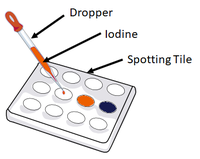Difference between revisions of "Method"
(→About Methods) |
|||
| (7 intermediate revisions by the same user not shown) | |||
| Line 14: | Line 14: | ||
|'''Results''' | |'''Results''' | ||
|- | |- | ||
| − | |[[File:IodineStarch.png|center| | + | |[[File:IodineStarch.png|center|200px]] |
| − | + | | style="height:200px; width:200px; text-align:left;"|'''Method''' | |
| − | | style="height:200px; width: | ||
: 1. Take a small sample of cheese, pasta, potato, chicken and bread | : 1. Take a small sample of cheese, pasta, potato, chicken and bread | ||
: 2. Place each sample in a different spot on the spotting tile and note their location. | : 2. Place each sample in a different spot on the spotting tile and note their location. | ||
: 3. Record the colour of the iodine before using it. | : 3. Record the colour of the iodine before using it. | ||
: 4. Use a dropper to add one drop of iodine to each food. | : 4. Use a dropper to add one drop of iodine to each food. | ||
| − | : 5. Record the colour of the iodine after using it. | + | : 5. Record the colour of the iodine after using it with each food. |
| + | |[[File:Results4.png|center|200px]] | ||
|} | |} | ||
| + | |||
| + | ==Key Stage 3== | ||
| + | ===Meaning=== | ||
| + | A [[method]] is the set of instructions that are followed to complete an [[experiment]]. | ||
| + | ===About Methods=== | ||
| + | :A [[method]] is written for an [[experiment]] so that others can [[reproduce]] the [[experiment]]: | ||
| + | :*To see if the [[experiment]] is [[valid]]. | ||
| + | :*To find out if you get the same [[result]]s everywhere. | ||
| + | :*To spot any major [[error]]s in the [[experiment]] that may cause [[Reliability|unreliable]] [[result]]s. | ||
| + | : [[Method]]s should be written in the form of "writing to instruct". They do not use any personal pronouns; I, you, he, she, we, or they. | ||
| + | : A [[method]] often has a [[diagram]] with it to identify how to set up the [[experiment]] or name the pieces of [[equipment]]. | ||
| + | |||
| + | ==Key Stage 4== | ||
| + | ===Meaning=== | ||
| + | A [[method]] is the set of instructions that are followed to complete an [[experiment]]. | ||
| + | |||
| + | ===About Methods=== | ||
| + | :A [[method]] is written for an [[experiment]] so that others can [[reproduce]] the [[experiment]]: | ||
| + | :*To see if the [[experiment]] is [[valid]]. | ||
| + | :*To determine if the same [[result]]s can be achieved everywhere. | ||
| + | :*To spot any major [[error]]s in the [[experiment]] that may cause [[Reliability|unreliable]] [[result]]s. | ||
| + | : [[Method]]s should be written in the form of "writing to instruct". They do not use any personal pronouns; I, you, he, she, we, or they. | ||
| + | : A [[method]] often has a [[diagram]] with it to identify how to set up the [[experiment]] or name the pieces of [[equipment]]. | ||
Latest revision as of 09:36, 21 March 2019
Contents
Key Stage 2
Meaning
A method is the set of instructions you follow to complete an experiment.
About Methods
- A method can be followed if you are trying to copy another person's experiment.
- A method can be written if you have created your own experiment and want other people to be able to copy it.
- Methods should be written in the form of "writing to instruct". They do not use any personal pronouns; I, you, he, she, we, or they.
- A method often has a diagram with it to identify how to set up the experiment or name the pieces of equipment.
Examples
| Diagram | Method | Results |
Method
|
Key Stage 3
Meaning
A method is the set of instructions that are followed to complete an experiment.
About Methods
- A method is written for an experiment so that others can reproduce the experiment:
- To see if the experiment is valid.
- To find out if you get the same results everywhere.
- To spot any major errors in the experiment that may cause unreliable results.
- Methods should be written in the form of "writing to instruct". They do not use any personal pronouns; I, you, he, she, we, or they.
- A method often has a diagram with it to identify how to set up the experiment or name the pieces of equipment.
Key Stage 4
Meaning
A method is the set of instructions that are followed to complete an experiment.
About Methods
- A method is written for an experiment so that others can reproduce the experiment:
- To see if the experiment is valid.
- To determine if the same results can be achieved everywhere.
- To spot any major errors in the experiment that may cause unreliable results.
- Methods should be written in the form of "writing to instruct". They do not use any personal pronouns; I, you, he, she, we, or they.
- A method often has a diagram with it to identify how to set up the experiment or name the pieces of equipment.

